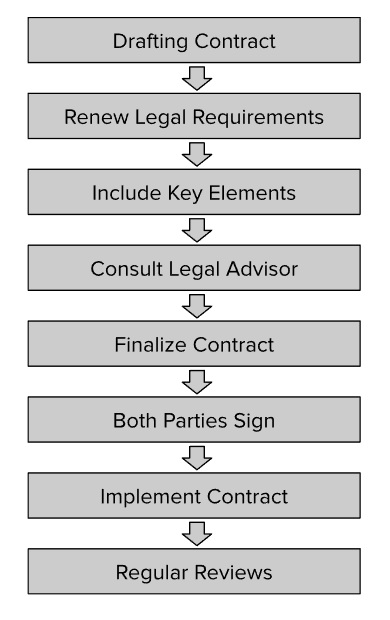Handbook on Employment Contracts and Agreements HR
HANDBOOK ON EMPLOYMENT CONTRACTS AND AGREEMENTS
Version: 1.0
Date: [Insert Date]
Table of Contents
-
Introduction
-
Types of Employment Contracts
-
Key Elements of an Employment Contract
-
Legal Requirements
-
Benefits and Compensation
-
Termination and Severance
-
Common Pitfalls and How to Avoid Them
-
Non-Disclosure Agreements (NDAs)
-
Employee Rights and Responsibilities
-
Dispute Resolution
-
Conclusion
-
Contact Information
-
Appendices
Introduction
Welcome to the Handbook on Employment Contracts and Agreements. This comprehensive guide, prepared by [Your Company Name], aims to provide employers, employees, and legal professionals with a thorough understanding of employment contracts and agreements. Whether you are drafting a new contract, reviewing an existing one, or seeking to understand the legal implications of these documents, this handbook will serve as a valuable resource.
Types of Employment Contracts
A. Permanent Employment Contracts
Permanent employment contracts are the most common type of employment agreement. These contracts do not have an end date and continue until either party decides to terminate the agreement. They are often used for full-time positions that require a long-term commitment from both the employer and the employee. In the case of [Company Name], a tech company, permanent employment contracts are the norm for software engineers, project managers, and other key roles.
B. Fixed-Term Contracts
Fixed-term contracts are for a specific duration, often used for project-based work or seasonal employment. These contracts automatically expire at the end of the term unless renewed. Employers and employees must be clear about the terms and conditions to avoid any misunderstandings. For example, at the retail company [Company Name], fixed-term contracts are commonly used for holiday staffing.
C. Casual and Zero-Hour Contracts
Casual and zero-hour contracts offer flexibility but do not guarantee a minimum number of work hours. These are often used in industries that require a flexible workforce, such as retail or hospitality. While these contracts offer more freedom, they also come with less job security. In the case of the restaurant chain [Company Name], casual contracts are used for waitstaff.
Key Elements of an Employment Contract
Every employment contract should contain certain key elements to be legally binding and clear in its terms. Below is a table that outlines these elements.
A. Key Elements
|
Element |
Description |
Legal Requirement (Yes/No) |
|
Job Title |
Specifies the role of the employee |
Yes |
|
Duration |
Length of the employment contract |
Yes |
|
Salary |
Compensation details |
Yes |
|
Benefits |
Additional perks and benefits |
No |
|
Termination Clause |
Conditions for contract termination |
Yes |
|
Non-compete Clause |
Restrictions on working for competitors |
No |
|
Confidentiality |
Protection of company information |
No |
Legal Requirements
Employment contracts must adhere to federal, state, and local laws. Failure to comply can result in legal repercussions for the employer. Always consult legal professionals when drafting an employment contract. It's crucial to be aware of the Fair Labor Standards Act (FLSA), Occupational Safety and Health Act (OSHA), and other relevant laws that govern employment contracts. For instance, in the state of [State Name], there are specific laws regarding overtime pay that must be considered.
Benefits and Compensation
|
Benefit Type |
Description |
Common Percentage of Salary |
|
Health Insurance |
Medical coverage |
3-5% |
|
Retirement Plans |
401(k), pension, etc. |
5-10% |
|
Bonuses |
Performance-based rewards |
5-20% |
|
Stock Options |
Ownership in the company |
Varies |
Termination and Severance
Termination clauses should be clearly defined in the employment contract. Severance packages, if offered, should also be detailed to avoid any misunderstandings. It's important to specify the notice period, reasons for termination, and any compensation that may be due upon termination. For example, at the company [Company Name], employees are entitled to a severance package equivalent to one month's salary for every year of service.
Common Pitfalls and How to Avoid Them
Understanding common pitfalls can save both employers and employees from future disputes and legal issues. The flowchart below outlines the steps to avoid these pitfalls.

Non-Disclosure Agreements (NDAs)
Non-disclosure agreements are often a part of employment contracts, especially in industries where confidential information is handled. NDAs protect the company's intellectual property and trade secrets. For example, at the pharmaceutical company [Company Name], NDAs are mandatory for all research and development staff.
Employee Rights and Responsibilities
Every employee has certain rights and responsibilities that should be clearly outlined in the employment contract. These may include the right to a safe working environment, the responsibility to adhere to company policies, and more. At the fictional construction company [Company Name], employee rights and responsibilities are detailed in a separate section of the employment contract.
Dispute Resolution
In case of any disputes between the employer and employee, the employment contract should specify the methods for resolution. This could include arbitration, mediation, or legal action. At the law firm [Legal Firm Name], dispute resolution clauses are standard in all employment contracts.
Conclusion
Employment contracts are a critical aspect of any professional relationship between an employer and an employee. Understanding the different types of contracts, key elements, legal requirements, and common pitfalls can help both parties create a mutually beneficial agreement. This handbook aims to serve as a comprehensive guide for anyone involved in the drafting, reviewing, or signing of employment contracts.
Contact Information
Email: [Your Company Email]
Address: [Your Company Address]
Phone Number: [Your Company Number]
For any queries, please contact [Your Name] at [Your Email].
Appendices
Appendix A: Federal Employment Laws
Appendix B: State-specific Employment Laws
Appendix B: Sample Employment Contracts